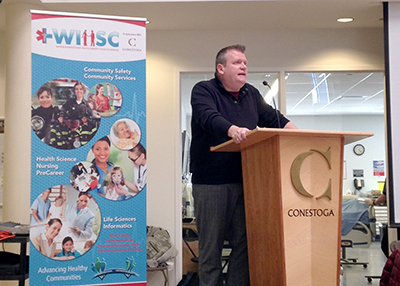On April 5, Conestoga’s WIHSC group (Waterloo Interprofessional Health and Community Student Collaborative) hosted an interactive workshop at the Doon campus that featured a panel of health care and community safety specialists from the region.

On April 5, Bill Davidson, executive director of Langs, spoke to health and community service students about Connectivity Tables - an interprofessional approach to handling the health and social service needs of clients at risk.
WIHSC members include students from the Nursing (RPN & RN), Respiratory Therapy, Paramedicine, Pre-Service Firefighting, Police Foundations, OTA/PTA, PSW and Social Work programs. Activities at the workshop included a mock “Connectivity Table” that provided students with an opportunity to observe an interprofessional approach to managing community services for individuals at risk.
Connectivity Tables first launched in Ontario in 2014 through a partnership between Langs Community Health Centre in Cambridge and the Waterloo Region Police Service. There are now 20 throughout the province. Each table brings together a wide range of health and community service agencies, such as police, family and child service workers, school board representatives, social workers and mental health specialists. Representatives from these organizations meet weekly at a Connectivity Table to review cases and coordinate immediate care, assistance and interventions for clients at risk. By improving service delivery between agencies, Connectivity Tables aim to reduce emergency room admissions, child protection cases, prosecutions and youth victimization.
“I thought the mock Connectivity Table was the perfect definition of interprofessionalism,” said Anna Enerio, a Respiratory Therapy student at Conestoga and vice president of WIHSC. “The Connectivity Table also increased understanding of how different health and community professions can transfer knowledge and work together to enhance health and community promotion and prevention.”
The mock Connectivity Table presented two cases for students in attendance: one involving abuse of an elderly woman and another that involved an at-risk youth. Through the demonstration, students were able to observe how regional community agencies work together at the Connectivity Table to determine interventions and coordinate care. Students were invited to ask questions after the presentation of each case.
“This is an amazing opportunity for students to see a demonstration of a model that’s already out in the community and one that’s working,” said Bill Davidson, executive director at Langs. He told students that he hoped they could see themselves around the table and encouraged them to keep the importance of interprofessionalism in mind when they return to class.
